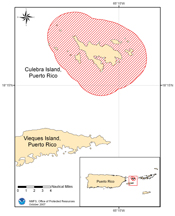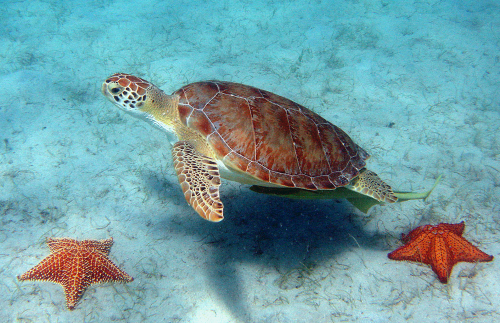Green Turtle (Chelonia mydas)
Status | Taxonomy | Species Description | Habitat | Distribution |
Population Trends | Threats | Conservation Efforts | Regulatory Overview |
Key Documents | More Info
| Photos
 Green Turtle (Chelonia mydas) Photo: Andy Bruckner, NOAA |
|||
|
Did You Know? · Comment on 90-day finding on petition to delist Hawaiian green turtle population and initiation of status review, through 10/01/2012. |
||
|
|||
| |||
 Green Turtle Critical Habitat (click for larger view PDF)  Green Turtle Range Map (click for larger view PDF) |
|||
Status
ESA Endangered - breeding populations in Florida and on the Pacific coast of Mexico
ESA Threatened - all other populations
Taxonomy
Kingdom: Animalia
Phylum: Chordata
Class: Reptilia
Order: Testudines
Family: Cheloniidae
Genus: Chelonia
Species: mydas
| Weight: | 300-350 pounds (135-160 kg) for adults; hatchlings weigh 0.05 lbs (25 g) |
| Length: | 3 feet (1 m) for adults; hatchlings are 2 inches (50 mm) |
| Appearance: | top shell (carapace) is smooth with shades of black, gray, green, brown, and yellow; their bottom shell (plastron) is yellowish white |
| Lifespan: | unknown, but sexual maturity occurs anywhere between 20-50 years |
| Diet: | seagrasses and algae |
| Behavior: | females return to the same beaches where they were born ("natal" beaches) every 2-4 years to lay eggs, generally in the summer months |
Green turtles are the largest of all the hard-shelled sea turtles, but have a comparatively small head.
Adult green turtles are unique among sea turtles in that they eat only plants; they are herbivorous, feeding primarily on seagrasses and algae. This diet is thought to give them greenish-colored fat, from which they take their name.
While nesting season varies from location to location, in the southeastern U.S., females generally nest in the summer between June and September; peak nesting occurs in June and July. During the nesting season, females nest at approximately two-week intervals. They lay an average of five nests, or "clutches." In Florida, green turtle nests contain an average of 135 eggs, which will incubate for approximately 2 months before hatching.
Habitat
Green turtles primarily use three types of habitat:
- beaches for nesting
- open ocean convergence zones
- coastal areas for "benthic" feeding
Adult females migrate from foraging areas to mainland or island nesting beaches and may travel hundreds or thousands of kilometers each way. After emerging from the nest, hatchlings swim to offshore areas, where they are believed to live for several years, feeding close to the surface on a variety of pelagic plants and animals. Once the juveniles reach a certain age/size range, they leave the pelagic habitat and travel to nearshore foraging grounds. Once they move to these nearshore benthic habitats, adult green turtles are almost exclusively herbivores, feeding on sea grasses and algae.
Critical Habitat
Critical habitat was designated in 1998 for green turtles in coastal waters around Culebra Island, Puerto Rico.
Distribution
The green turtle is globally distributed and generally found in tropical and subtropical waters along continental coasts and islands between 30° North and 30° South. Nesting occurs in over 80 countries throughout the year (though not throughout the year at each specific location). Green turtles are thought to inhabit coastal areas of more than 140 countries.
In U.S. Atlantic and Gulf of Mexico waters, green turtles are found in inshore and nearshore waters from Texas to Massachusetts, the U.S. Virgin Islands, and Puerto Rico. Important feeding areas in Florida include the Indian River Lagoon, the Florida Keys, Florida Bay, Homosassa, Crystal River, Cedar Key, and St. Joseph Bay.
In the eastern North Pacific, green turtles have been sighted from Baja California to southern Alaska, but most commonly occur from San Diego south. In the central Pacific, green turtles occur around most tropical islands, including the Hawaiian Islands. Adult green turtles that feed throughout the main Hawaiian Islands undergo a long migration to French Frigate Shoals in the Northwest Hawaiian Islands, where the majority of nesting and mating occurs.
Population Trends
The two largest nesting populations are found at:
- Tortuguero, on the Caribbean coast of Costa Rica, where 22,500 females nest per season on average
- Raine Island, on the Great Barrier Reef in Australia, where 18,000 females nest per season on average
In the U.S., green turtles nest primarily along the central and southeast coast of Florida where an estimated 200-1,100 females nest annually.
In a 2004 Green Turtle Assessment ![]() , the Marine Turtle Specialist Group
, the Marine Turtle Specialist Group ![]() (MTSG) of the IUCN
(MTSG) of the IUCN ![]() classified green turtles as endangered globally. Analyses of historic and recent abundance information by the MTSG indicates that extensive population declines have occurred in all major ocean basins over approximately the past 100-150 years. The MTSG analyzed population trends at 32 index nesting sites around the world and found a 48-65% decline in the number of mature females nesting annually over the past 100-150 years.
classified green turtles as endangered globally. Analyses of historic and recent abundance information by the MTSG indicates that extensive population declines have occurred in all major ocean basins over approximately the past 100-150 years. The MTSG analyzed population trends at 32 index nesting sites around the world and found a 48-65% decline in the number of mature females nesting annually over the past 100-150 years.
 Green Turtle with fibropapillomatosis (Chelonia mydas) Photo: © Ursula Keuper-Bennett/Peter Bennett. Copyright Information |
- harvest of eggs and adults (historically, though the practice continues in some areas of the world)
- incidental capture in fishing gear
- fibropapillomatosis (disease)
- general threats to marine turtles
The principal cause of the historical, worldwide decline of the green turtle is long-term harvest of eggs and adults on nesting beaches and juveniles and adults on feeding grounds. These harvests continue in some areas of the world and compromise efforts to recover this species.
Incidental capture in fishing gear, primarily in gillnets, but also in trawls, traps and pots, longlines, and dredges is a serious ongoing source of mortality that also adversely affects the species' recovery.
Green turtles are also threatened, in some areas of the world, by a disease known as fibropapillomatosis (FP).
For more information, please visit our threats to marine turtles page.
Conservation Efforts
In the U.S., NOAA Fisheries and the U.S. Fish and Wildlife Service (USFWS) have joint jurisdiction for green turtles, with NOAA having the lead in the marine environment and USFWS having the lead on the nesting beaches. Both federal agencies, and a number of state agencies, have promulgated regulations to eliminate or reduce threats to sea turtles.
In the Atlantic and Gulf of Mexico, we have required measures (such as gear modifications, changes to fishing practices, and time/area closures) to reduce sea turtle bycatch in pelagic longline, mid-Atlantic gillnet, Chesapeake Bay pound net, and southeast shrimp and flounder trawl fisheries.
We have worked closely with the shrimp trawl fishing industry to develop turtle excluder devices (TEDs) to reduce the mortality of sea turtles incidentally captured in shrimp trawl gear. TEDs that are large enough to exclude even the largest sea turtles are now required in shrimp trawl nets. We have provided extensive TED training throughout the world.
Since 1989, the U.S. has prohibited the importation of shrimp harvested in a manner that adversely affects sea turtles. The import ban does not apply to nations that have adopted sea turtle protection programs comparable to that of the U.S. (for example, require and enforce the use of TEDs) or to nations where incidental capture in shrimp fisheries does not present a threat to sea turtles (that is, nations that fish for shrimp in areas where sea turtles do not occur). The U.S. Department of State is the principal implementing agency of this law, while we serve as technical advisor.
In 2003, we developed the Strategy for Sea Turtle Conservation and Recovery in Relation to Atlantic and Gulf of Mexico Fisheries (Strategy) to evaluate and address domestic sea turtle bycatch comprehensively across jurisdictional (that is, state and Federal) and fishing sector (both commercial and recreational) boundaries on a per-gear basis in fisheries of the Atlantic and Gulf of Mexico.
We are currently involved in cooperative gear research projects designed to reduce sea turtle bycatch in the Gulf of Mexico and Atlantic pelagic longline fisheries, the Hawaii-based deep set longline fishery, the Atlantic sea scallop dredge fishery, the Chesapeake Bay pound net fishery, and non-shrimp trawl fisheries in the Atlantic and Gulf.
Green turtles are protected by various international treaties and agreements as well as national laws:
- Appendix I of the Convention on International Trade in Endangered Species of Wild Flora and Fauna (CITES), which means that international trade of this species is prohibited
- Appendices I and II of the Convention onMigratory Species (CMS)
 and are protected under the following instruments of CMS:
and are protected under the following instruments of CMS:
- Memorandum of Understanding on the Conservation and Management of Marine Turtles and their Habitats of the Indian Ocean and South-East Asia (IOSEA)
- Memorandum of Understanding Concerning Conservation Measures for Marine Turtles of the Atlantic Coast of Africa
- Annex II of the Specially Protected Areas and Wildlife (SPAW)
 Protocol of the Cartagena Convention
Protocol of the Cartagena Convention - The U.S. is a party to the Inter-American Convention for the Protection and Conservation of Sea Turtles (IAC), which is the only binding international treaty dedicated exclusively to marine turtles
- Memorandum of Understanding on ASEAN Sea Turtle Conservation and Protection

- Memorandum of Agreement on the Turtle Islands Heritage Protected Area (TIHPA)

 Green Turtle (Chelonia mydas) Photo: © Caroline S. Rogers, USGS |
Regulatory Overview
The green turtle was listed under the ESA on July 28, 1978. The breeding populations in Florida and the Pacific coast of Mexico are listed as endangered; elsewhere the species is listed as threatened.
In 1992, we finalized regulations to require turtle excluder devices (TEDs) in shrimp trawl fisheries to reduce interactions between turtles and trawl gear. Since then, we have modified these regulations as new information became available on increasing the efficiency of TEDs (for example, larger TEDs are now required to exclude larger turtles).
In 1998, we designated critical habitat for green turtles to include the coastal waters around Culebra Island, Puerto Rico.
We implement measures to reduce sea turtle interactions in fisheries by regulations and permits under the ESA and Magnuson-Stevens Fishery Conservation and Management Act. Since the early 1990s, we have implemented sea turtle conservation measures including, but not limited to, TEDs in trawl fisheries, large circle hooks in longline fisheries, time and area closures for gillnets, and modifications to pound net leaders. Click here for a list of our regulations to protect marine turtles.
Key Documents
(All documents are in PDF format.)
| Title | Federal Register | Date |
|---|---|---|
Petition to Delist Hawaiian Population
|
77 FR 45571 |
02/16/2012 08/01/2012 |
| 5-Year Review | n/a | 08/31/2007 |
| Virginia Pound Net Fishery Regulations | 71 FR 36024 | 06/23/2006 |
| IUCN Red List 2004 Green Turtle Assessment |
n/a | 04/2004 |
| Critical Habitat - Culebra Island, Puerto Rico | 63 FR 46693 | 09/02/1998 |
| Recovery Plan - East Pacific Green Turtle | 63 FR 28359 | 05/22/1998 |
| Recovery Plan - Pacific Green Turtle | 63 FR 28359 | 05/22/1998 |
| TED Regulations for Shrimp Trawls | 57 FR 57348 | 12/04/1992 |
| Recovery Plan - Atlantic Green Turtle | n/a | 10/29/1991 |
| ESA Listing Rule | 43 FR 32800 | 07/28/1978 |
- Kids' Times: Green Sea Turtle [pdf]
- NOAA's National Marine Sanctuaries Encyclopedia
- Green Turtle DNA Sequence from Southwest Fisheries Science Center
- U.S. Fish and Wildlife Service Green Turtle Species Profile
- Sea Turtle Recovery Planning
- Marine Turtle Related Links
Updated: August 1, 2012

